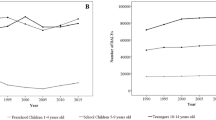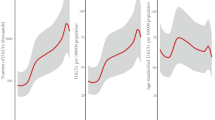Abstract
Vision impairment and blindness are strongly associated with aging and late-life disability. While home to about 17% of the world’s population, an estimated 25% of visually impaired people globally live in India. This proportion is expected to increase as India’s population rapidly ages and continues to grow. There is a need for up-to-date epidemiologic data on the prevalence of vision impairment and blindness in India and on the socioeconomic determinants of poor vision, especially among older adults, to promote visual and overall health and well-being in later life. This paper uses newly available data from Wave 1 (2017–2019) of the population-based Longitudinal Ageing Study in India to estimate the overall and sex-specific prevalence of presenting visual acuity impairment and blindness among individuals aged 45 and older at the national level and for all constituent states and union territories. Overall, 33.8% (95% confidence interval: 33.31%, 34.26%) of the Indian population aged 45 and older had distance visual acuity impairment or was blind (visual acuity in the better-seeing eye < 20/40). The age-standardized prevalence varied considerably among states (22.3–54.6%), and women were more likely than men to be visually impaired or blind in all states. Near visual acuity impairment was also highly prevalent (76.3%, 95% confidence interval: 75.88%, 76.77%). Vision impairment and blindness were more common among marginalized groups and were associated with lower socioeconomic status. Findings from this study are relevant for surveillance of vision health, design of targeted eye care policies and programs and efforts to promote human and economic development.
This is a preview of subscription content, access via your institution
Access options
Access Nature and 54 other Nature Portfolio journals
Get Nature+, our best-value online-access subscription
$29.99 / 30 days
cancel any time
Subscribe to this journal
Receive 12 digital issues and online access to articles
$119.00 per year
only $9.92 per issue
Buy this article
- Purchase on Springer Link
- Instant access to full article PDF
Prices may be subject to local taxes which are calculated during checkout

Similar content being viewed by others
Data availability
The LASI dataset analyzed in this study is available through the Gateway to Global Aging Data repository (https://g2aging.org/?section=lasi-downloads). To access the dataset, the user needs to create an account on Gateway to Global Aging Data and complete the Data Access Use Agreement (online form). The LASI team reviews the request and verifies the identity and institutional affiliation. Once this authentication process has been completed, the team will authorize access to the desired dataset. This process usually takes 1 week.
Code availability
Statistical code is available upon request.
Change history
24 November 2023
A Correction to this paper has been published: https://doi.org/10.1038/s43587-023-00541-8
References
Institute for Health Metrics and Evaluation. GBD compare. https://vizhub.healthdata.org/gbd-compare/ (2021).
National Academies of Sciences, Engineering and Medicine. Making Eye Health a Population Health Imperative: Vision for Tomorrow. https://doi.org/10.17226/23471 (National Academies Press, 2016).
World Health Organization. World Report on Vision (World Health Organization, 2019).
Burton, M. J. et al. The Lancet Global Health Commission on Global Eye Health: vision beyond 2020. Lancet Glob. Health 9, e489–e551 (2021).
United Nations. Transforming our World: the 2030 Agenda for Sustainable Development (United Nations, 2015).
United Nations. General Assembly Resolution 75/310. Vision for Everyone; Accelerating Action to Achieve the Sustainable Development Goals (2021).
Zhang, J. H. et al. Advancing the sustainable development goals through improving eye health: a scoping review. Lancet Planet Health https://doi.org/10.1016/s2542-5196(21)00351-x (2022).
Bourne, R. R. A. et al. Trends in prevalence of blindness and distance and near vision impairment over 30 years: an analysis for the Global Burden of Disease Study. Lancet Glob. Health 9, e130–e143 (2021).
Murthy, G. V. S., Gupta, S. K., Bachani, D., Jose, R. & John, N. Current estimates of blindness in India. Br. J. Ophthalmol. https://doi.org/10.1136/bjo.2004.056937 (2005).
Neena, J., Rachel, J., Praveen, V. & Murthy, G. V. S. Rapid assessment of avoidable blindness in India. PLoS ONE 3, e2867 (2008).
Mactaggart, I., Limburg, H., Bastawrous, A., Burton, M. J. & Kuper, H. Rapid assessment of avoidable blindness: looking back, looking forward. Br. J. Ophthalmol. 103, 1549–1552 (2019).
Ministry of Health & Family Welfare Government of India. National Blindness and Visual Impairment Survey 2015–2019—a summary report. MoHFW, New Delhi, India (2019).
Ehrlich, J. R., Stagg, B. C., Andrews, C., Kumagai, A. & Musch, D. C. Vision impairment and receipt of eye care among older adults in low- and middle-income countries. JAMA Ophthalmol. 137, 146–158 (2019).
Foreman, J. et al. Prevalence and causes of visual loss among the indigenous peoples of the world a systematic review. JAMA Ophthalmol. 136, 567–580 (2018).
Perianayagam, A. et al. Cohort profile: the Longitudinal Aging Study in India. Int. J. Epidemiol. 51, e167–e176 (2019).
Bloom, D. E., Sekher, T. V. & Lee, J. Longitudinal Aging Study in India (LASI): new data resources for addressing aging in India. Nat. Aging 1, 1070–1072 (2021).
International Association for the Prevention of Blindness. IAPB vision atlas. https://www.iapb.org/learn/vision-atlas/ (2020).
Flaxman, A. D., Vos, T. & Murray, C. J. An Integrative Meta-regression Framework for Descriptive Epidemiology (Univ. Washington Press, 2015).
World Health Organization. ICD-11 for Mortality and Morbidity Statistics (version: 04/2019). 9D90 Vision Impairment Including Blindness (2019).
Smits, J. & Permanyer, I. The Subnational Human Development Database. Sci. Data 6, 190038 (2019).
Poddar, A. K. et al. Prevalence and causes of avoidable blindness and visual impairment, including the prevalence of diabetic retinopathy in Siwan district of Bihar, India: a population-based survey. Indian J. Ophthalmol. 68, 375–380 (2020).
Prasad, M., Malhotra, S., Kalaivani, M., Vashist, P. & Gupta, S. K. Gender differences in blindness, cataract blindness and cataract surgical coverage in India: a systematic review and meta-analysis. Br. J. Ophthalmol. 104, 220–224 (2020).
Reddy, P. A. et al. Effect of providing near glasses on productivity among rural Indian tea workers with presbyopia (PROSPER): a randomised trial. Lancet Glob. Heal. 6, e1019–e1027 (2018).
Arokiasamy, P. et al. in Aging in Asia: Findings From New and Emerging Data Initiatives (eds Smith, J. P. & Majmundar, M.) https://www.ncbi.nlm.nih.gov/books/NBK109220/ (National Academies Press, 2012).
International Institute for Population Sciences, National Programme for Health Care of Elderly, MoHFW, Harvard T. H. Chan School of Public Health & the University of Southern California. Longitudinal Ageing Study in India (LASI) Wave 1, 2017–18, India Report (International Institute for Population Sciences, 2020).
Ahmad, O. B. et al. Age Standardization of Rates: a New WHO Standard. GPE Discussion Paper Series, No. 31 (World Health Organization, 2001).
Stevens, G. A. et al. Guidelines for accurate and transparent health estimates reporting: the GATHER statement. Lancet 388, e19–e23 (2016).
Acknowledgements
A.A., C.Y., J.L. and D.E.B. were supported by the US National Institute on Aging (5R01AG042778). J.R.E. is supported by a grant from the US National Eye Institute (K23EY027848) and an unrestricted grant to the University of Michigan Department of Ophthalmology and Visual Sciences from Research to Prevent Blindness. The authors thank Indzara (https://indzara.com/) for providing the image template for Fig. 1.
Author information
Authors and Affiliations
Contributions
J.R.E. performed conceptualization and design of the study, planning of analyses, interpretation of results and drafting of the manuscript. A.A. performed conceptualization and design of the study, planning of analyses, data analysis, interpretation of results and drafting of the manuscript. C.Y. performed data analysis, interpretation of results and drafting of the manuscript. J.L. performed conceptualization and design of the study, planning of analyses, oversight of study team and critical revision of the manuscript. D.E.B. performed conceptualization and design of the study, planning of analyses, oversight of study team and critical revision of the manuscript.
Corresponding author
Ethics declarations
Competing interests
The authors declare no competing interests.
Peer review
Peer review information
Nature Aging thanks Gudlavalleti Murthy and David Rein for their contribution to the peer review of this work.
Additional information
Publisher’s note Springer Nature remains neutral with regard to jurisdictional claims in published maps and institutional affiliations.
Supplementary information
Supplementary Information
Supplementary Tables 1–5 and GATHER checklist
Source data
Source Data Fig. 1
Statistical source data for Fig. 1 in Excel format.
Rights and permissions
Springer Nature or its licensor (e.g. a society or other partner) holds exclusive rights to this article under a publishing agreement with the author(s) or other rightsholder(s); author self-archiving of the accepted manuscript version of this article is solely governed by the terms of such publishing agreement and applicable law.
About this article
Cite this article
Ehrlich, J.R., Agarwal, A., Young, C. et al. The prevalence of vision impairment and blindness among older adults in India: findings from the Longitudinal Ageing Study in India. Nat Aging 2, 1000–1007 (2022). https://doi.org/10.1038/s43587-022-00298-6
Received:
Accepted:
Published:
Issue Date:
DOI: https://doi.org/10.1038/s43587-022-00298-6



